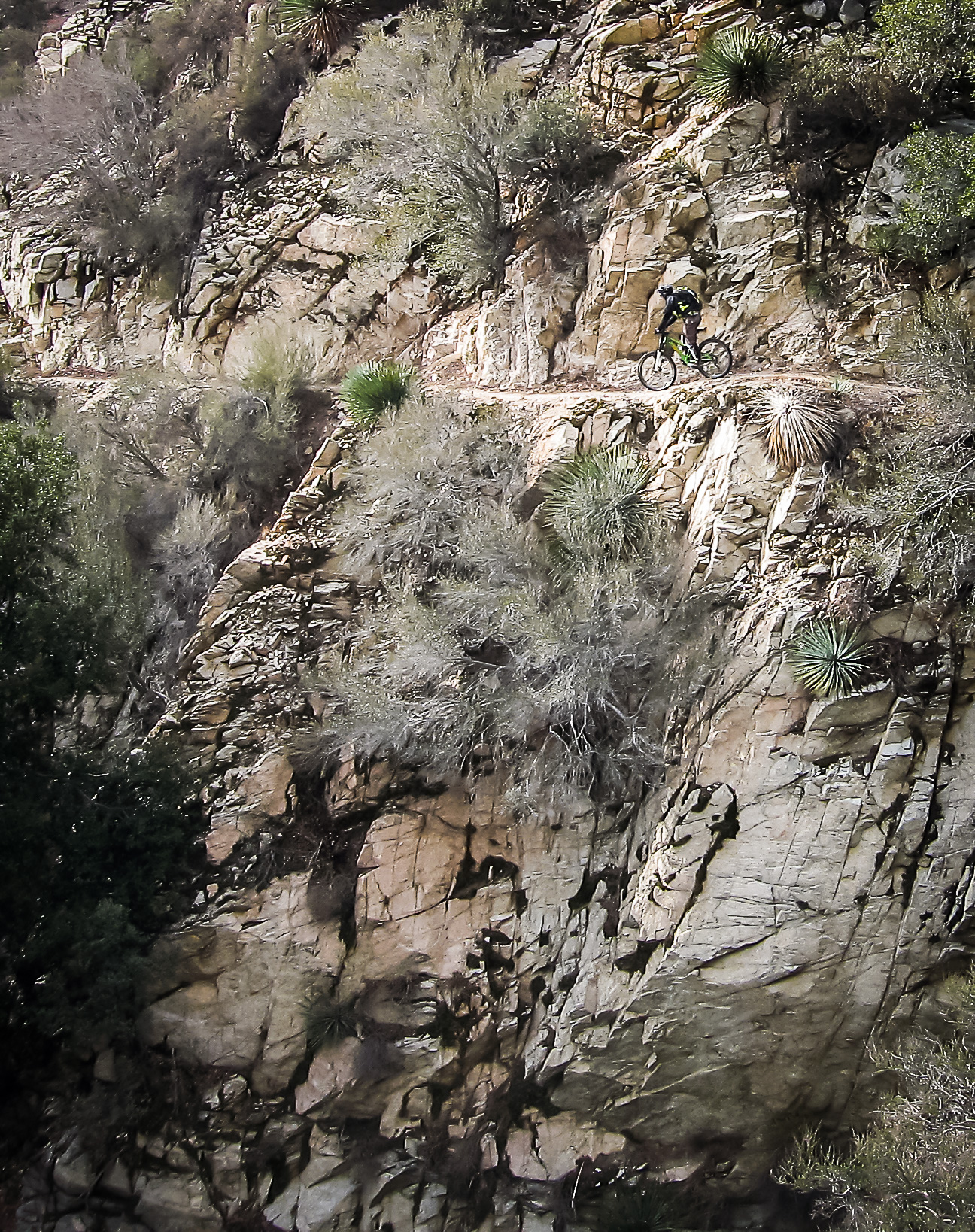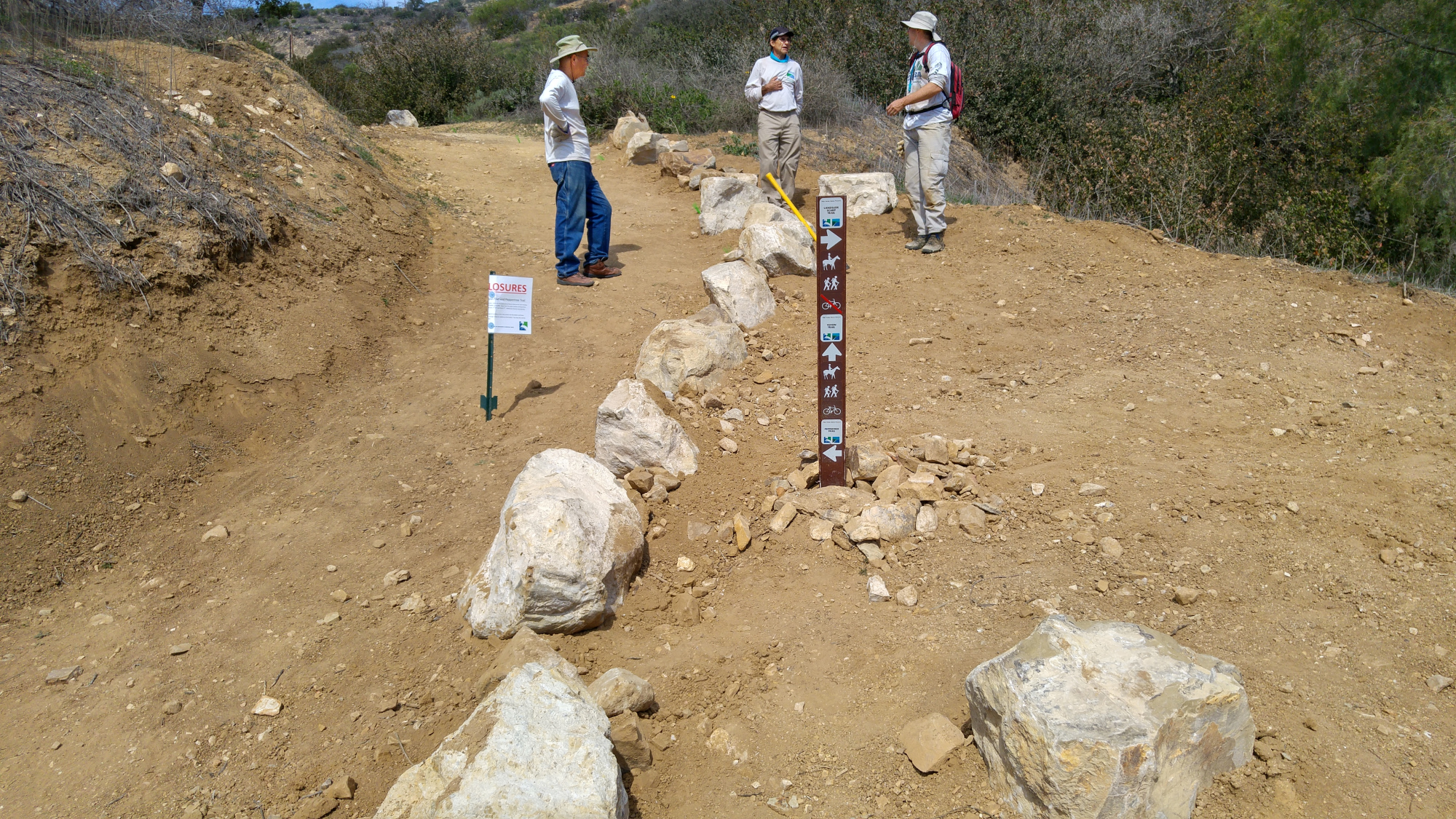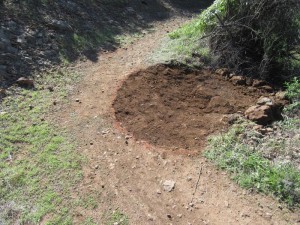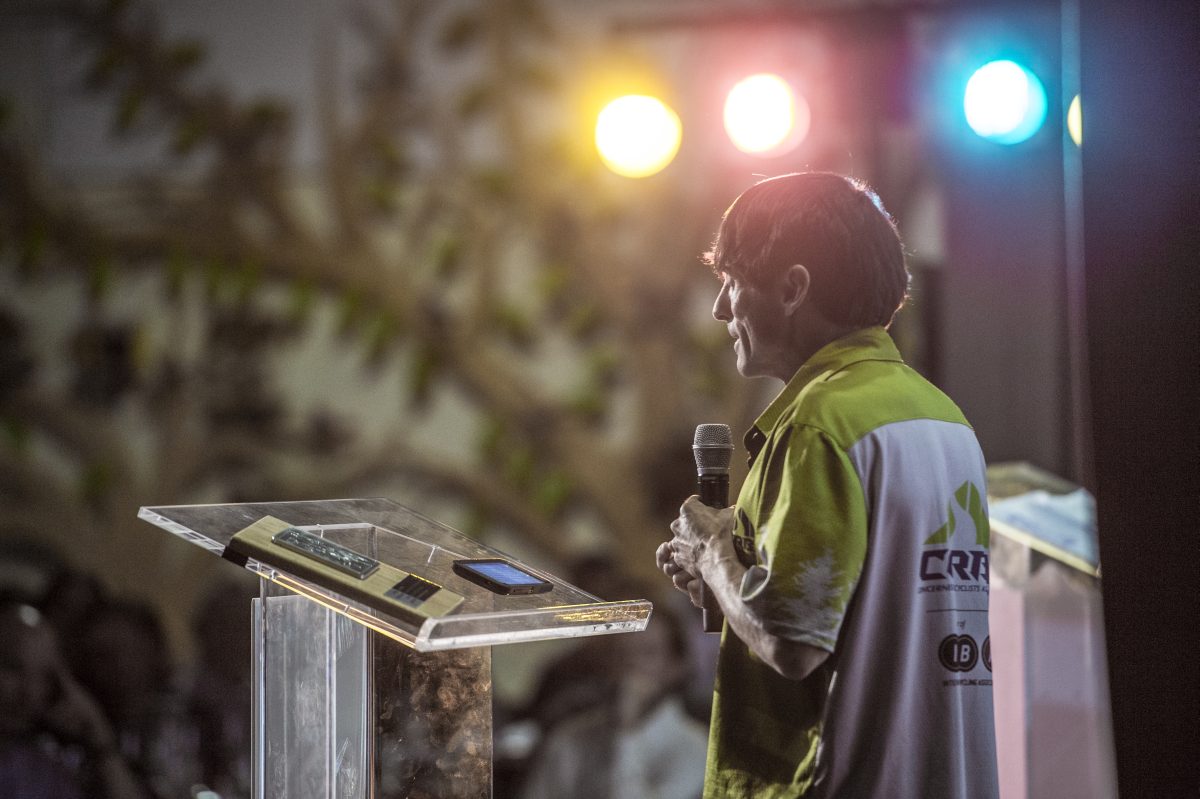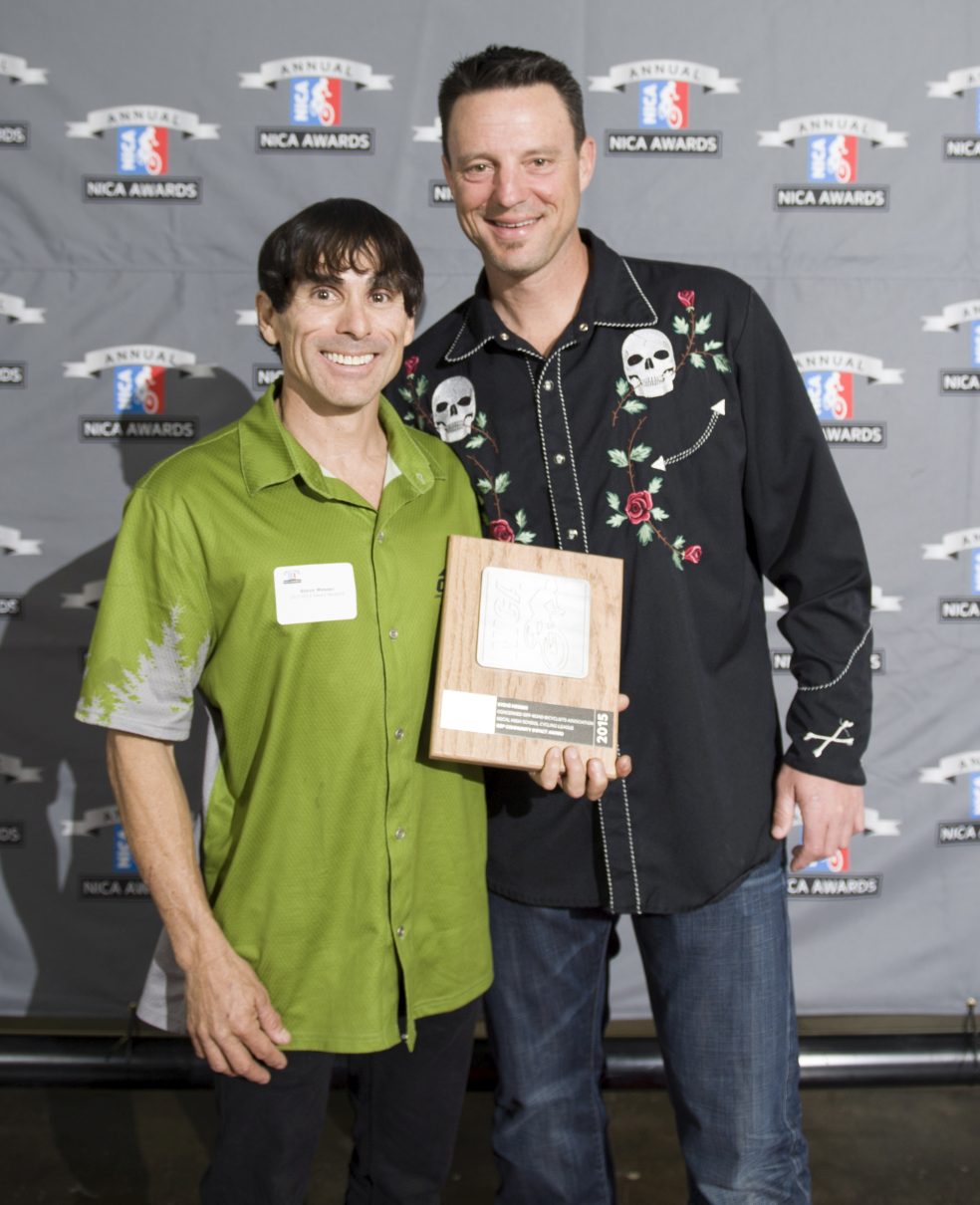We had another unusually large class of 24 on a cool, cloudy day in Malibu Creek State Park this month at the Basic Skills Clinic. The clinic is always held the first Saturday of the month. You can see the photos in our March photo gallery.
March Skills Clinic photos posted March 6
March 6th, 2016March 2016 eTerraTimes Newsletter Published March 3
March 3rd, 2016The March 2016 edition of CORBA’s monthly newsletter, the eTerraTimes, was published today, March 3. If you don’t get it by email, you can view it online.
As always, the eTerraTimes has all the latest news for mountain bikers in the Santa Monica Mountains and surrounding areas.
President’s Message: The Wilderness Debate
March 3rd, 2016Currently mountain bike advocacy is facing one of the the most important long-term issues in our history. The issue is whether mountain bikes should be allowed on trails in Wilderness areas. How mountain bikers and advocacy leaders respond to this can either be polarizing or make us an even stronger voice in the trail user and land stewardship community.
In Idaho Montana, the Wood River Bicycle Coalition, an IMBA chapter, worked with IMBA to build support for a National Monument rather than a Wilderness area. Over a period of several years, negotiations with wilderness advocates, motorized and other recreation groups and elected officials formed a broad coalition of support. However, raw ugly politics ultimately produced a Congressional designation for the Boulder White Clouds Wilderness. This was a painful and well-publicized loss to the mountain biking community. The land protection provisions they had negotiated in good faith to produce a bicycle-friendly National Monument designation were ultimately lost to a crass political maneuver to deny President Obama any semblance of a success. Congress passed a Wilderness bill and the Castle Divide and Ant’s Basin trails were closed to bikes.
Meanwhile, attorney Ted Stroll had been continuing his research into the Wilderness Act, and the congressional debates and intent surrounding that landmark legislation as it was enacted in 1964. He had concluded that the original intent was never to exclude bicycles, as a human-powered form of low-impact recreation, from Wilderness areas. Further research led him to believe that, in accordance with our constitution, we have the right to bring our grievances to the U.S. government. To do this, he formed the Sustainable Trails Coalition (STC), whose sole mission is to pass legislation that would allow local land managers to open trails to bicycles in Wilderness, and to authorize the use of machinery that would allow the most cost-effective and efficient maintenance on Wilderness trails, on a case-by-case, trail-by-trail basis.
How many mountain bikers view the wilderness ban on bikes
The timing of the Idaho defeat brought heightened attention to the STC and their focused, single-issue mission. It cast doubt in the mountain biking community about the effectiveness of IMBA’s approach of building broad partnerships and seeking compromises to both protect bicycle access, while protecting the landscapes through which we ride bikes with a mix of Wilderness boundary adjustments, cherry-stems, and alternative designations. This approach has been highly successful in many instances, but there have been some exceptions, with this loss in Idaho being the most recent and the most publicized.
Here in the Angeles National Forest, we’ve lost access to much of the backcountry trail network on our Forest. This has placed increased use pressure on non-Wilderness trails by all user groups. Trail maintenance on Wilderness trails has come to a near-halt in many areas, and all user groups are losing those trails to nature. We don’t have any bicycle-legal singletrack options to traverse the San Gabriel Mountains north-south, or east-west, because of numerous closed trails, Wilderness designations, and restrictions on bicycles on the Pacific Crest Trail. Similarly, in the Sierra, Inyo, and Sequoia National Forests there are vast swaths of Wilderness and a few isolated areas that are open to bikes, many of which are currently being evaluated for Wilderness (and, remarkably, the folks who maintain many Wilderness trails and can’t keep up with the workload have objected to any new Wilderness.).
These Wilderness losses are very much a localized issue, affecting California and the Western States disproportionately to other areas. California has the most Wilderness areas of any state, and is second only to Alaska in Wilderness acres. Here in CORBA’s territory, we have the largest population base in the country near a National Forest. 1 in 20 Americans live within easy driving distance of the Angeles National Forest, with its five Wilderness areas and additional Recommended Wilderness taking nearly one third of the Forest.
Recreational activities are greatly reduced in Wilderness areas compared to non-wilderness areas, even if bicycles are left out of the equation. Maintenance efforts are greatly reduced and near-impossible for the Forest Service to schedule, as the cost of manual labor to rebuild trails (no mechanized tools allowed, even wheelbarrows) means these trails often don’t get worked on. While the same can be said of many lesser-used non-wilderness trails, this doesn’t bode well for the future of Wilderness trail recreation.
It also disproportionately affects a smaller subset of the mountain biking community who seek out, relish, and live for backcountry wilderness-type settings that can be experienced by bicycle. It’s why I started mountain biking, and what inspires me to continue exploring and experiencing these majestic landscapes. Sure, I love purpose-built flow trails, downhill trails, and our many favorite local trails. They are needed, but they don’t offer the same experience and escape that some of us live for. We need a broad spectrum of experiences and trail types to cover the many diverse reasons for which people ride mountain bikes, including wilderness-type experiences.
There have been calls for IMBA to take a stronger stand on the Wilderness access issue in print media, the blogosphere, and on social media. In fact, if you have followed closely, the amount of grandstanding on both sides of the bikes in wilderness debate has escalated. From reading some of what has been published, one could easily come away with the assumption that mountain bikers have to pick a side: either support the Sustainable Trails Coalition or support IMBA. Over the past month there have been many calls, emails and forum posts asking to cancel IMBA memberships.
Some writers in the print media have accused IMBA of taking a hardline stance against the STC, but there is much more nuance to their statements that has been overlooked. IMBA hasn’t condemned the STC or opposed their efforts. In fact, IMBA has for many months taken a neutral public policy position toward STC’s strategy, neither supporting nor opposing. Publicly, IMBA has simply stated that the STC approach is not appropriate for IMBA’s mission, given STC’s single focus, uphill battle, risks and uncertain future.
Singletracks.com, an internet blog, found the vast majority of mountain bikers surveyed support bicycle access to wilderness. The Angry Singlespeeder gave his take on the issue, calling it the most pressing of our time, and followed it this year with an Open Letter to every IMBA member calling on us to demand IMBA to listen to its membership and take a more proactive stance towards the STC. Former IMBA Board Member John Bliss explained why he joined the STC board, with some compelling arguments.
Pressure continues to mount calling for IMBA to support the STC, or at the bare minimum, take a more conciliatory stance and acknowledge the common ground that exist between the two organizations. IMBA have held a press conference explaining their position, posted an FAQ on land protection strategies they will continue to utilize, and conducted four Chapter Leader Executive Briefings with question and answer sessions with approximately 100 chapter leaders nationwide, which I attended. Many forum comments have construed their public arguments and tone as denigrating and dismissive of the STC, but in direct conversations with IMBA staff, that tone is much more nuanced.
With all this attention on Wilderness, one could be misled into thinking that this was the only issue facing mountain bikers. Admittedly, it is probably the most far-reaching issue that could fundamentally change our approach, as mountain bikers, to land protections nationwide, and especially in the Western states like California. But there are still plenty of more immediate issues and opportunities that need immediate, focussed attention, and that is where IMBA has chosen to put its limited resources and energy.
We see this “us vs. them” dichotomy as far from the case. The fact that IMBA has chosen not to support STC does not infringe upon anyone’s first amendment right to speak up for and support the STC, including us as a chapter of IMBA. IMBA’s (and CORBA’s, for that matter) plate is full with current mountain biking issues, and the vast amount of attention and resources needed to achieve the STC’s mission and focus on Wilderness access would hinder our ability to tend to more immediate threats, identify new opportunities, take advantage of current opportunities, and just get things done now.
We believe we need both organizations. STC’s single, focussed mission is to enact legislation that will allow management of wilderness trail access (and mechanized maintenance) to happen at the most local level feasible. STC is not a membership organization and as such is not structured for or able to do anything on the ground right now to open closed trails to bikes or develop and maintain positive relationships with land managers that are key to our future successes. It will be a difficult struggle and take some time before STC’s efforts may prove fruitful.
IMBA chapters are currently doing the vast majority of advocacy and access work at the local levels. If STC is eventually successful in passing their legislation it will likely be IMBA chapters doing the necessary outreach and hands-on work to give the STC’s legislation teeth, by working directly with local land managers to open trails under the authority of STC’s Human Powered Wildlands Travel Management Act of 2016 (HPWTMA).
Despite what has been claimed by the Wilderness Society and others opposed to bicycles in Wilderness, the STC bill doesn’t open ANY trails to bikes or mechanized maintenance. It allows the “most local” land managers feasible (likely district rangers and supervisors) to make those determinations on a case-by-case, trail-by-trail basis. That’s why IMBA chapters will need those strong relationships when and if the time comes.
You can bet the opposition to bikes will only get louder when that happens, both locally and nationally. It will be IMBA chapters with current, strong land manager relations that will be best positioned to follow through on any STC success. Land managers aren’t just going to open trails to bikes in wilderness areas if the STC bill is eventually enacted. If the STC bill does go through–and let’s be clear that we hope it eventually will–IMBA Chapters will need to actively engage with local land managers to open trails to bikes under the newly granted authority of STC’s legislation. Even then, those trail openings will probably require a lengthy NEPA process, and may come with restrictions. Permits, capacity limits, mandatory leave-no-trace classes, or other hurdles could be put in place as a part of that Wilderness access. Passing of the HPWTMA is just the starting point to opening trails in Wilderness.
In the meantime if people start choosing to drop support for IMBA chapters to support the STC, that will impede our ability to get things done now, such as bike parks, trail maintenance, new trails, and being a crucial voice in current land management and trail planning efforts. If CORBA/IMBA is weakened by an attrition of supporters now, it will hinder our ability in the future to build upon any STC success, and open trails currently closed to bikes by Wilderness designations.
One of the best things that STC is doing is bringing more attention to this major access issue. What saddens and frustrates us is that social media are misinterpreting some of IMBA’s responses, and turning this into an “us vs. them” situation, which will weaken our efforts on both fronts. We’d much preferred to have a more conciliatory tone from IMBA towards STC, even in the absence of outright support. IMBA has alienated a portion of their members through their statements and firm stance. That just doesn’t need to be so.
There is room–and a great need–for another group like STC to give the Wilderness issue the razor-sharp focus it will need to see through.
IMBA is a 501c3 and cannot directly lobby our government to introduce new legislation, endorse political candidates, and other restrictions. IMBA (and CORBA) are set up as 501c3 public benefit corporations, that can only influence existing laws and policies through public comments, broad-based partnerships with other organizations, and encouraging our members to speak up with their own comments and letters to elected representatives and land managers.
STC is set up as a 501c4, with the specific purpose of directly lobbying congress and our elected officials to enact change at the legislative level. They are able to do things that IMBA and CORBA cannot. It’s important to note that the Sierra Club is a 501c4, just like the STC. They have a companion 501c3, the Sierra Club Foundation, which collects tax-deductible donations that can then be used to support the lobbying efforts of their 501c4. They also operate under budgets 100 times larger than IMBA’s. Most mountain bikers are decidedly lackadaisical in their approach to advocacy–until their favorite trail is closed, or threatened to be closed. And as previously mentioned, while most mountain bikers support opening some trails in Wilderness to bicycles, the number of riders who may eventually utilize wilderness trails is likely much lower.
The mountain biking community has never had a 501c4 organization to stand behind before the STC came along. Just as the Sierra club leverages both a 501c3 and a 501c4 for various, but related, purposes, the mountain biking community has needed both a 501c3 and a 501c4 voice. As mentioned, where we see things have gone awry is that IMBA’s firm but neutral stance has been twisted and construed in social media and the blog/print media as an “us vs. them” situation.
IMBA’s approach is appropriate for IMBA. The STC approach is appropriate for STC. Together, they have brought more attention to this contentious debate, and hopefully helped engage a new cadre of concerned mountain bikers ready to advocate for continued access to trails–both inside and outside of Wilderness. Both organizations are advocating for increased trail access. They are just employing different strategies and tactics.
Let me re-iterate that in the long run, if STC is successful, strong IMBA chapters will be best positioned to make the changes that STC’s bill will authorize. We’ll then need to leverage our ongoing track record of being good land and trail stewards, and work side-by-side with local land managers to open trails in Wilderness areas. We’ll need to work hard to usher those requests through the NEPA process, and deal with the opposition to bikes that will inevitably emerge. If our voice is weakened by a lack of support now, we’ll be in a more difficult position to ask for trails to be opened under the STC bill’s authority in the future.
If STC is unsuccessful, IMBA chapters like CORBA will continue to work to make a difference, just as we have been doing for more than 29 years. We just hope to have the continued–and even increased– level of support we now get from our members.
But things at IMBA have changed somewhat. Their 2016 advocacy position clearly states that they will continue to fight more aggressively to keep trails open in the face of Wilderness proposals, wherever there are local chapters available to do the local on-the-ground work needed. They have been emboldened to take a firmer stance than ever before to prevent trail closures, within the constraints they operate under as a 501c3. Wilderness and environmental advocates are finding it increasingly difficult to pass Wilderness legislation when advocacy groups like IMBA and its chapters are directly and strongly opposed. IMBA is also investigating the merits of a legal challenge to recent trail access losses in the Bitterroot National Forest in Idaho. They have expressed a desire to legislatively adjust existing Wilderness boundaries to open trails that have been closed to bikes (without any changes to the Wilderness Act itself). But their stance falls short of lobbying for sweeping change at the legislative level, which is precisely what STC is positioned to do.
CORBA and IMBA have on a number of occasions asked for “language-based exemptions” to prohibitions on bikes on specific trails in new Wilderness proposals. We’ve usually been turned down on these requests as being “incompatible with the intent of the Wilderness Act” even though numerous language-based exemptions exist for purposes other than bicycle travel and recreation, and the STC’s contention that the “intent” of the Wilderness Act has been misinterpreted in current regulations. Yet what STC is proposing is making such language-based exemptions (or, more accurately, allowing Forest Service orders to authorize access) for bicycles and trail maintenance, an integral part of an amended Wilderness Act.
Let’s not have this issue divide us, weaken us, and allow us to be conquered. Our members can support both STC and CORBA/IMBA, and both organizations will be stronger for it. While we applaud the STC for their approach, CORBA will continue to work on efforts that have immediate, near-term benefit to all mountain bikers and our public lands: trail maintenance, management plan advocacy, currently pending bills, land manager relations, education, and stewardship.
We also hope that one day, CORBA will be in a position to ask our local land managers to open trails in current Wilderness areas to bikes, under the authority of STC’s legislation. But until then, we have to stay strong, stay united, and keep striving towards making immediate, short-term differences, happy in the knowledge that STC is working on a long-term strategy that most of our members agree would be a step in the right direction for all of us.
CORBA Palos Verdes Trailwork Report
March 2nd, 2016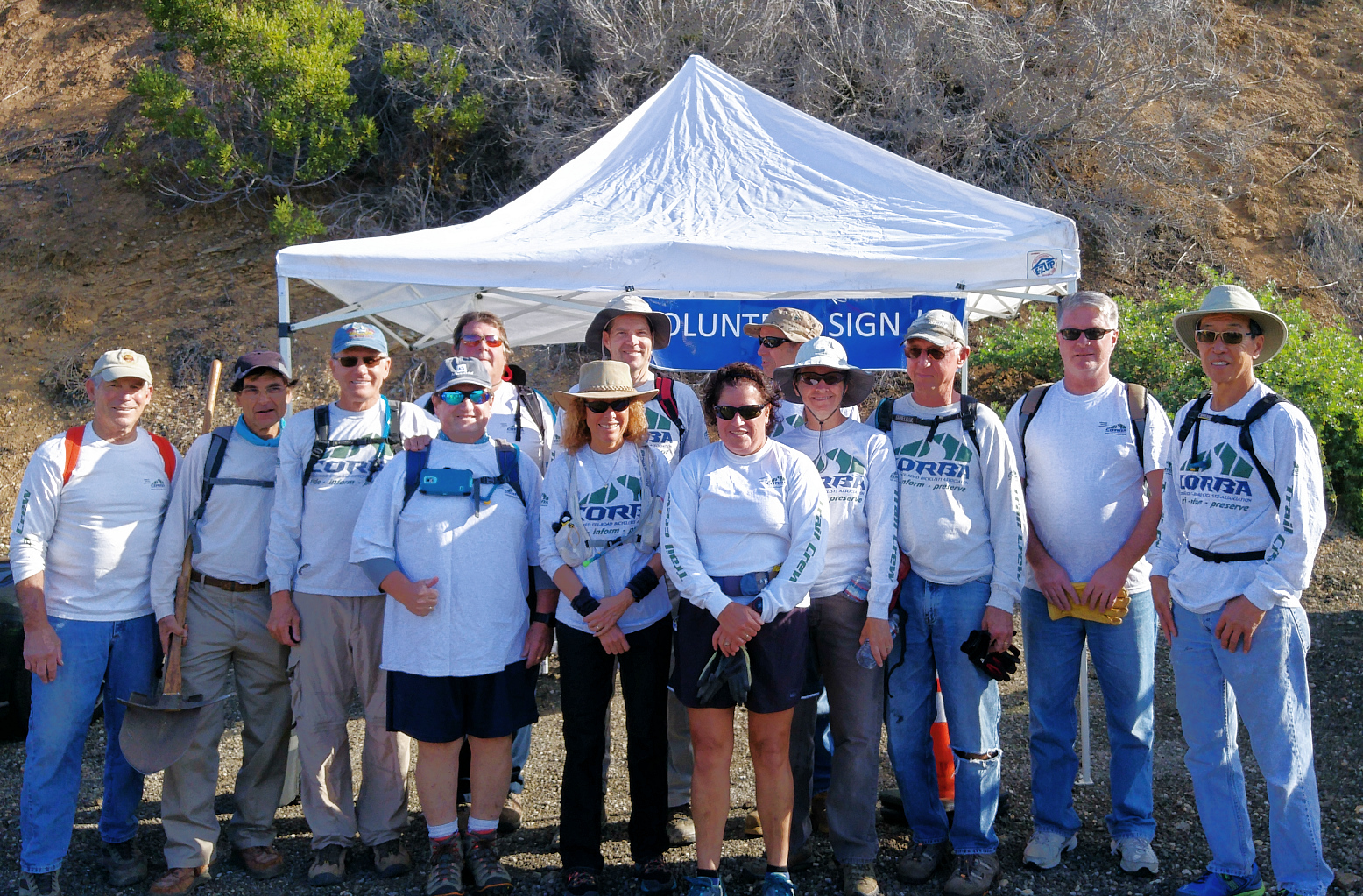
On Saturday, February 27, 2016, fifteen dedicated CORBA volunteers came out to support the City of Rancho Palos Verdes efforts to restore the Toyon Trail. Organized by long-time CORBA PV coordinator Troy Braswell, the group took part in trail repairs, invasive weed removal, and planting native shrubs. They worked alongside City employees and other volunteers. Cory Linder, from the City’s Parks & Recreation department was on hand to oversee and coordinate all the volunteer efforts.
The City of RPV has been conducting ongoing restoration work every Saturday in February, with the final work day scheduled for this coming weekend, March 5th. To learn more about volunteer opportunities in Rancho Palos Verdes, visit http://www.rpvca.gov, and stay on top of RPV happenings at CORBA Palos Verdes.
We are happy to see the RPV Parks & Rec department stepping up their volunteer program, and are even happier to be able to contribute. Thanks to all the dedicated volunteers who came out to improve the trails and landscape for everyone!
GGR: Girlz Gone Riding News!
March 2nd, 2016
GGR is so very excited to announce a NEW location for this year’s annual Rocktober Festival & CORBA membership drive! This year the Rocktober Festival will be held at beautiful Castaic Lake October 30th, 2016. Castaic Lake
The festival consists of guided cross country rides, skills clinics, guest speakers, exhibitors, giveaways, tons of demo bikes and best of all………this is a FREE event for all GGR club members. Children will be welcomed at this year’s festival as well. Registration goes up August 31st. The festival closes at 300 pre registered riders. For more event details, check out the GGR site here: Rocktober Festival October 30th 2016

Director Wendy Engelberg becomes an official Ambassador for Specialized Bikes.
Director of GGR Wendy Engelberg was more than thrilled to accept a Specialized ambassadorship for 2016. What exactly does this mean? It means Wendy will continue to work in the community bringing on women mountain bikers, keeping women cycling, being an advocate for women’s mountain biking and working closely with Specialized: Specialized and Cynergy Cycles: Cynergy Cycles a Specialized Concept store. Wendy will be at Cynergy Cycles once a month bringing women out on demo rides and guiding them in with their new mountain biking journey. She will also assist Specialized with dirt demos. For 2016, Wendy will be riding a Specialized women’s specific bike. The Specialized ERA Expert: Specialized ERA
Read the complete story here: GGR Director Signs on with Specialized
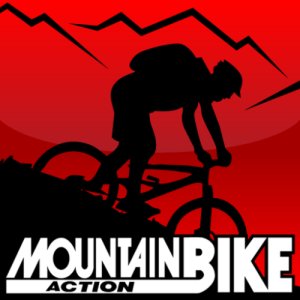
Look for the April issue of Mountain Bike Action on sale March 3rd. Wendy wrote a feature for MBA called: “How to get your wife or girlfriend to love mountain biking” (Hint: Stay out of it!)
Thanks to our model Anne Russell, Jose Gonzales and photographer Jesse Ettinger for making this happen. Also a shout out to GGR Coach Christine Hirst who helped with the article as well. Please purchase the magazine and if you love the piece, let the editor know! It’s important to give them feedback to keep the articles relative to women AND men coming!
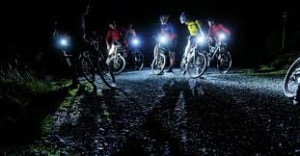 GGR CO-ED NIGHT RIDES ARE BACK IN MARCH! Check out our March Calendar for our summer CO ED evening rides. All level, no drop rides! Some Thursday nights, some Wednesday nights. GGR Calendar
GGR CO-ED NIGHT RIDES ARE BACK IN MARCH! Check out our March Calendar for our summer CO ED evening rides. All level, no drop rides! Some Thursday nights, some Wednesday nights. GGR Calendar
Monthly Club Rides!
If you didn’t know, GGR’s monthly ladies only club ride is the last Saturday of every month. Times will change when the heat becomes a factor.
Join our Board Meeting every 4th Monday
March 1st, 2016 Come and join us to learn about current issues and let us know what concerns you! Always open to the public, the CORBA Board of Directors’ meeting is held the 4th Monday of the month in Woodland Hills. REI is kind enough to let us use their meeting room, for which we thank them profusely!
Come and join us to learn about current issues and let us know what concerns you! Always open to the public, the CORBA Board of Directors’ meeting is held the 4th Monday of the month in Woodland Hills. REI is kind enough to let us use their meeting room, for which we thank them profusely!
Every month (except December, when we have no meeting), we discuss these topics:
- Issues of trail access for mountain bikers
- Mountain bike advocacy and ambassadorship
- Public involvement
- The latest news from the land managers, including State Parks and National Park Service
- Trail building and restoration
- Furthering woman’s mountain biking
- Bike parks and other dedicated mountain bike facilities or trails
- Education and etiquette
- Anything brought forward by members of the public
The meetings are 6:30 – 8 pm at the REI in Woodland Hills:
6220 Topanga Canyon Blvd
Woodland Hills, CA 91367
P: (818) 703-5300
We look forward to seeing you there!
Volunteers restore the Backbone Trail near Yerba Buena
February 29th, 2016Ten CORBA and 17 other volunteers helped to restore 3/4 miles of the Backbone Trail (Yerba Buena segment) this past Saturday February 27.

The outside berm of the trail is pulled back to fill in the rut, and to give it a slight slope so water will run off it, rather than down it. This is called ‘outsloping’ the trail.
This trail was built about 12 years ago and has had very little, if any maintenance work done on it since. Overall it has held up very well, which shows how well it was designed and constructed, but the lack of rainfall over the past several years has certainly contributed to its longevity.
Nevertheless, most of the original drainages were completely filled with silt and had become ineffective, allowing water to run down the middle of the trail, developing and enlarging ruts. As such, most of our work was spent fixing ruts, and repairing drainages or building new ones, to keep ruts from re-forming or enlarging. One long-time volunteer used a gas-powered hedge trimmer to cut back the brush that was starting to impinge on the trail while two people followed along behind to dispose of the cuttings.
This CORBA crew embarked on a task that was new to us by completely rebuilding a section of the trail about 100′ long. The berm on the outside of the trail that keeps the water on it was chopped up. The dirt was then dragged back over the trail, filling in the center rut and used to re-establish the normal outslope that allows water to flow straight across and off the outside edge of the trail, rather then down the middle to make a rut. This took about three hours. For the rest of the day we joined in the other volunteers in clearing and building drainages.
We packed up about 2 pm, a littler earlier than usual, then some CORBA volunteers drove into Thousand Oaks for thank-you lunch on CORBA at the Stonefire Grill.
Thanks to all the CORBA and other volunteers who came out to help restore this trail! There are many more photos in our Feb 27th photo gallery for you to view.
COSCA Spring Trailwork Day March 19th
February 29th, 2016Come out and join the Conejo Open Space Conservation Agency (COSCA), CORBA, the Santa Monica Trails Council and other volunteers for the Annual COSCA Spring Trailwork Day. We will be working to restore part of Space Mountain (Los Robles West) and other nearby multiuse trails.
 At noon, following the morning of trail-building, workers will be treated to hamburgers / vegi-burgers, chips, fruit and drinks while enjoying the camaraderie of fellow trail enthusiasts!
At noon, following the morning of trail-building, workers will be treated to hamburgers / vegi-burgers, chips, fruit and drinks while enjoying the camaraderie of fellow trail enthusiasts!
Wear protective clothing (long-legged pants, long-sleeved shirts, sunglasses), sturdy shoes, gloves, hat and sunscreen.
No experience is necessary and you work at a pace that is comfortable for you. Tools and instructions on how to use them safely and effectively will be provided. Must be 18+ years of age or accompanied by a parent or other responsible adult. Beware of poison oak, ticks & rattlesnakes.
Follow directions of park rangers and trail crew leaders at all times.
Pre-registration is required so that COSCA will have enough tools, crew leaders and food!
Directions to the meeting place and other details are included on the online registration page.
CORBA’s Steve Messer Receives NICA Award
February 29th, 2016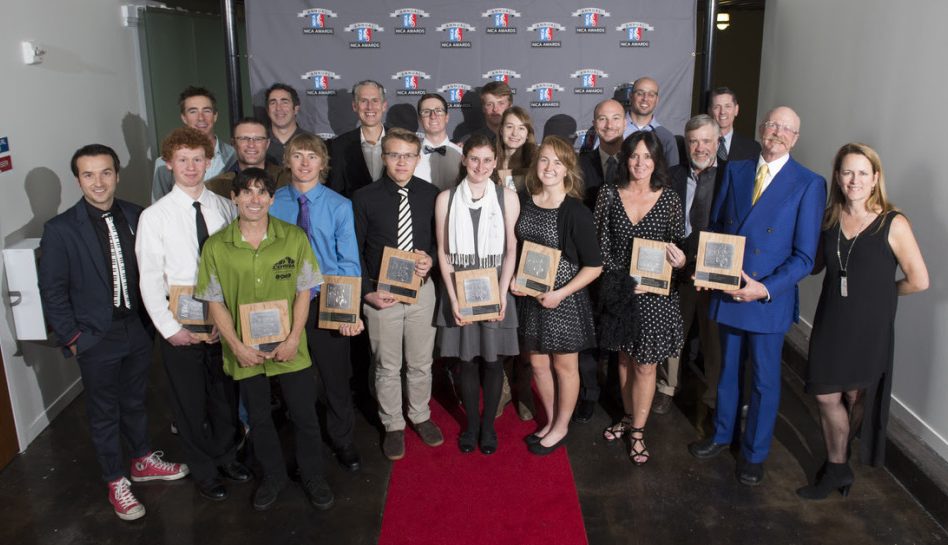
2015 NICA Award Recipients. Top row: Todd Wells, Hal Miller, Scott Armstrong, Austin McInerny, Jeremy Call, Kade Brantington, Hannah Heydinger, Robert Parks, Mark LaPaglia, and Mike Perry. Bottom Row: Lucas Euser, Liam Ruff, Steve Messer, Nash Dory, Preston Bagley-Gurtner, Esmée DeBarssi, Zoë Mae Dunn, Kathy Parks, Robert Kertesz, Gary Fisher and Lauren Duensing. Photo credit: Karl Nielsen.
On January 30, 2016, Steve Messer was the honored recipient of the National Interscholastic Cycling Association’s Community Impact Award, sponsored by QBP. The award came as a complete surprise to CORBA’s President, and was equally unexpected by SoCal League director Matt Gunnell, with whom Steve and CORBA have work since the league’s infancy to support High School Mountain Biking and getting more kids on bikes.
Read about all of NICA’s 2015 Award Recipients at Nationalmtb.org
Sixteen outstanding participants in high school cycling leagues across the U.S. were honored at the 2015 National Interscholastic Cycling Association (NICA) Awards, held at Clif Bar & Company Headquarters, in Emeryville, California.
NICA presented awards in ten categories to individuals and organizations considered to be the most outstanding student-athletes, dedicated coaches, and the most supportive volunteers and sponsors to have helped advance the high school mountain biking movement over the past year. Photos of the entire event by by Karl Nielsen are available, and a short recap video will be posted soon.
Steve has been involved since a young riding buddy introduced him to high school mountain biking as the League was beginning its second season in 2010. The SoCal league’s first season had proved the NorCal model could be replicated, and led to the formation of NICA. Steve has been involved in getting student-athletes and teams out doing trailwork, doing major Station Fire restoration projects, helping secure venues for high school league races, and calling on High School teams to use their voice in advocacy efforts.
Steve was introduced by Matt Gunnell, director of the SoCal High School Cycling League, with whom Steve has worked, strategized, and even presented at the IMBA World Summit on the synergies between high school mountain biking and advocacy.
Matt’s introduction to Steve:
I am very honored to present the Quality Bicycle Products Community Impact Award to Steve Messer. Reading from the nomination submission for this award, I quote…”Steve does it all. He’s an inspiration. He’s indefatigable. He’s designed and built courses, mentored coaches and students, helped with administration, helped launch new teams, established partnerships between teams and IMBA chapters to do trail work, and more. This is just a sketch of his contributions. His commitment to the SoCal League is immense, and he still makes time for CORBA/IMBA advocacy leadership as well as general road bike advocacy. With 1000 Steves, mountain bike opportunities would be improved a thousand times over. Sadly, there’s only one of him.” It is with great pleasure that I present this award to the one and only Steve Messer!
Steve’s Acceptance Speech:
What a privilege to be here at the Clif Bar headquarters surrounded by so many people dedicated to getting more kids on bikes.
Thank you Matt for that introduction, and thank you so much NICA for this unexpected honor. There are many people I have to thank, especially the teams, coaches and volunteers of the SoCal League, and NICA for thier leadership. I know there were other equally-deserving nominees whose work is just as impactful and important as what I’ve been trying to accomplish. I’m just one of many, many mountain biking advocates around the country, striving to preserve and create great mountain biking experiences for our future generations.
Just five months after 76 SoCal League student-athletes raced the inaugural SoCal finals in 2009, and NICA was just getting going, our local National Forest and most of our favorite trails were destroyed by the Station Fire and subsequent El Niño storms. We had this burgeoning high school sport, and most of the trails I had ridden for more than 25 years were suddenly closed or gone. The Mountain biking community was devastated. My motivation to restore the trails, and some forward-thinking coaches who were already doing trailwork, grew into a serendipitous partnership between CORBA and local high school teams that needed places to ride and train.
Working with a half-dozen or more local high school teams and their coaches, boy scout troops, and other groups, we collectively restored most of the front-country trails within three years of the fire. We’re still working on restoration projects, and continue to have student-athletes joining us. In fact we have two teams coming out next weekend for trailwork. Not coincidentally, the recipient for the Distinguished Alumni Award, Jeremy Call, will be bringing out his team next weekend. It’s a win-win for the teams, for our public lands and for all trail users.
Early on it became obvious to me that this was the next generation of land and trail stewards, advocates, and even land managers. Restoring trails and giving these student-athletes a place not only to ride and train, but to develop a deep connection to the mountains and the Forest as I have been fortunate enough to experience, is its own reward. The most gratifying aspect of all this is that I’m seeing the passion I have for trails and our public lands instilled in so many young riders.
Having an increased presence of well-behaved, responsible trail users that NICA’s leagues are producing is really helping foster more responsible riding. The equestrian community in our area certainly has noticed Slomo Bro is helping spread the message that responsible riding is a form of advocacy.
Within the high school mountain biking family, I’ve made some of my closest friends, my strongest supporters and allies, and feel a true community spirit. I’m awed to feel this trail love spreading throughout this community. Seeing the types of partnerships CORBA began to develop, now built upon and expanded as the nationwide Teen Trail Corps Initiative with IMBA and REI gives me great confidence in the future of our sport, our trails and the places we ride.
Again, I’m truly honored by this recognition, especially since it’s for something I just love doing. Thank you NICA, the SoCal League, QBP for sponsoring this award, all the volunteers who have helped me along the way, my spouse who is so supportive of what I’m doing, and everyone who has contributed to this incredible journey.”
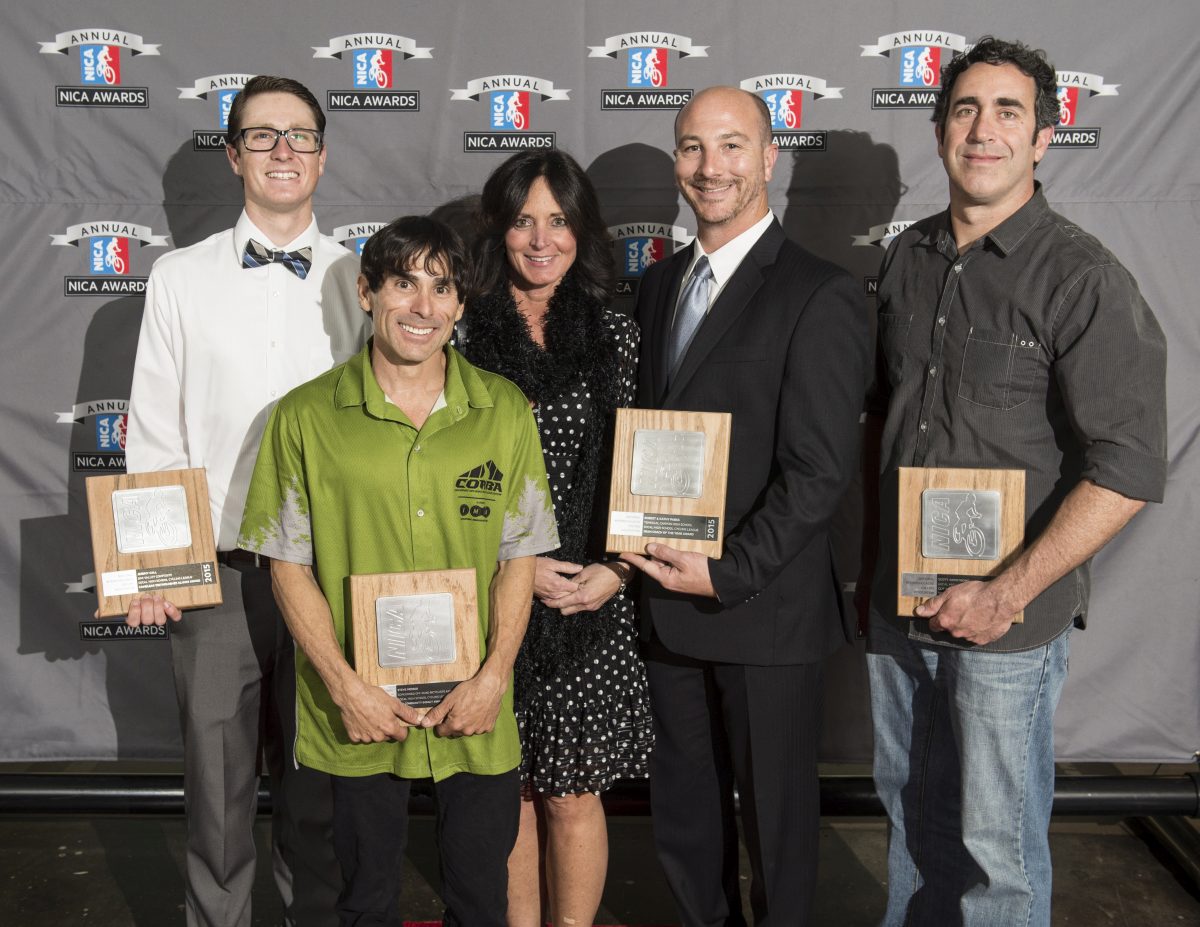
SoCal was well represented: Jeremy Call, Steve Messer, Kathy Parks, Robert Parks, and Scott Armstrong. Photo by Karl Nielsen
Southern California was well represented at the Awards, with Scott Armstrong, the SoCal League’s Chief Course Marshall receiving the Clif Bar Volunteer Service Award, Coach Jeremy Call from Simi Composite team receiving the Camelbak Distinguished Alumni Award (and then bringing his team out for CORBA trailwork a week later!), and coaches Robert and Kathy Parks of the Temescal Canyon High School receiving the SRAM Coach of the Year award.
NICA leagues are now up and running in 19 states, with more coming online each year. There are now over 10,000 student-athletes participating in middle school and high school mountain biking races around the country. To learn more, visit http://SoCaldirt.org, or http://Nationalmtb.org.
Neighborhood Councils Support Bike Park; Sapwi Trails and Puente Hills Update
February 28th, 2016Last week, the Encino Neighborhood Council Parks Committee heard a presentation from Steve Messer of CORBA and DJ Cosgrove of the LA Bike Park Collective about our proposal for a bicycle skills park in the Sepulveda Basin. The Parks committee raised some concerns in how our proposal might impact a proposed veterans memorial park for the same general area, so rather than support our specific proposal for Pedlow Field, they supported the concept of a bike skills park somewhere in Sepulveda Basin.
Late last year, the Lake Balboa Neighborhood Council gave a full endorsement to the proposal, asking “can we make this happen tomorrow?” The LBNC has already written a letter of support to the councilmember and the Rec and Parks department expressing their enthusiasm to see the project happen.
With the support of both local neighborhood councils, and public support in well over 2000 petition signatures (You can sign here if you haven’t already), including both online and locally sourced signatures, we are now in a good position to approach the Parks Department and City Councilmember Nury Martinez to formalize our proposal and begin the planning process.
We’ll keep you updated as things develop. When the time comes for public meetings, we’ll need to have a show of support: people turning up in person to meetings to ask for and demand a bike park facility for this unused patch of dirt in the Sepulveda Basin. A show of numbers is the strongest and most compelling argument that can be made to urge the parks department to move forward on our proposal.
Thousand Oaks
In 2012, when the City of Thousand Oaks was debating what to do with the Sapwi Trails Regional Park, for which they had spent considerable funds in developing an elaborate, but ultimately infeasible master plan, they reached out to the public. We rallied the local troops to show up in numbers. We filled a room with over 100 people asking for a bike park. After a series of subsequent meetings, the draft plan was begun, including the called-for bike park facilities.
We recently learned that the revised master plan for Sapwi Trails is still going forward with the bike skills park and trails included. The plan also calls for a model aircraft field, off-leash dog park, nature reserve areas and other amenties. It is scaled back from the original infeasible plan that was originally developed. The plan is currently undergoing an environmental review process under CEQA. The Conejo Rec and Parks Department expects to present the final plan to their Parks Commission later this year for approval. Construction could begin as soon as Fall 2017.
Puente Hills
The Puente Hills Landfill Park Master Plan has released their final draft. Included in that draft is a bike skills park to be developed on the Western Deck as a part of Phase One. Phase one will be the first to be constructed between 2017 and 2019. When that plan is presented before the County of Los Angeles Board of Supervisors, CORBA will be there to speak up in support of the bike park and trail components of the plan, and we could use as many people as are willing to speak in support. That won’t be expected until later this year or early next year.
Los Angeles County Park Needs Assessment
Currently Los Angeles County is doing a County-Wide Park Needs Assessment. At each of the 172 planned meetings, the public are being asked what are the conditions of their current parks, what type of park facilities are missing (answer: Bike Parks!), and what they would like to see as additions or improvements to their local parks.
CORBA has attended a number of these meetings and consistently raised the question of Bike Park facilities. The more people who attend these meetings and ask for bike parks, the more likelihood there is that they will begin an earnest effort to provide bike parks throughout the County.
Other projects:
We have other bike park proposals and projects in various stages of planning and development, but these are the most promising and important at this time. Our other proposals include Castaic Lake, which is being considered within the Castaic Area Trail Master Plan by Los Angeles County, the City of Glendale.
We are exploring other opportunities in other areas, and will continue to seek opportunities to bring more mountain biking opportunities to more areas around Los Angeles and Ventura County.
As a participating member of the Los Angeles Bike Park Collective, CORBA would like to see bike skills parks and pump tracks as common as Skateboard parks: at least one in each Council district, and one in each County district. There is certainly demand, but in many neighborhoods, residents have never seen or heard of bike skills parks, so they don’t know to ask for them. Once the word gets out, we’re confident that they will become increasingly common.




